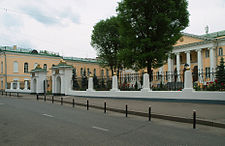Lazarian School
| Embassy of Armenia in Moscow Посольство Армении в Москве |
|
|---|---|
 |
|
| Coordinates | 55°45′37.5186″N 37°38′5.3664″E / 55.760421833°N 37.634824000°ECoordinates: 55°45′37.5186″N 37°38′5.3664″E / 55.760421833°N 37.634824000°E |
| Location | Moscow, Russia |
| Address | 2 Armenian Lane (2 Армянский переулок) |
| Ambassador | Oleg Yesayevich Yesayan |
The Lazarev Institute of Oriental Languages, (Armenian: Արևելյան լեզուների Լազարյան ինստիտուտ) established in 1815, was a Moscow school specializing in orientalism, particularly that of Armenia, and the cultural center of the Armenian diaspora in Russia. Many Russian scholars specializing in Transcaucasia received their education at the institute. The former Institute in Armyansky Lane is a listed memorial building and currently houses the Embassy of Armenia in Moscow.
The institute was established in 1815 by the Lazarev (Lazarian) family. In 1827 control passed to the Ministry of Public Education, the school was renamed the Lazarev Institute of Oriental Languages, and was remodeled as a special gymnasium with language courses in Arabic, Armenian, Persian, and Turkish. By 1844 the school had 105 students, of which 73 were Armenians, 30 Russians, and 2 others.
In 1848 the institute was upgraded to a lyceum, and in this new form trained Armenian school teachers and priests. As the Russian empire expanded through the Caucasus and Central Asia, the institute became central to the training of Russian civil servants and interpreters. In 1872 it was formally divided into two sections, one of which continued as a gymnasium, while the other presented a three-year course in the Armenian, Persian, Arabic, Turkish, and Georgian languages, history, and culture.
Between 1919 and 1920, the institute was renamed first the Armenian Institute, then the Southwest Asian Institute, then the Central Institute of Modern Oriental Languages, and finally the Moscow Institute of Oriental Studies. By the 1930s the institute had lost its students, and its library was transferred to the Moscow's Lenin Library.
...
Wikipedia
